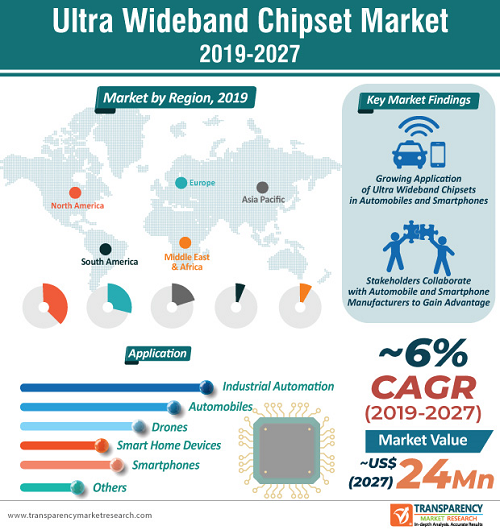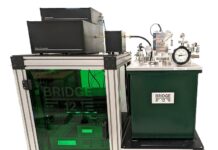
The ultra-wideband technology can be defined as an ultra low power wireless technology, which is used to transfer a large amount of data in short distances.
The UWB technology is capable of transmitting data at the rate of 1 gigabit per second in a radius of 10 meters for wireless personal area communications. It can carry a huge amount of data over distances up to 230 feet. It can also carry the data across barriers, such as doors or cross other obstacles due to its high power.
The current trend of manufacturers introducing new UWB technology-based chipsets with additional features and fulfilling customer needs is driving the growth of the UWB market.
For instance, Decawave has announced its new next-generation Ultra Wideband (UWB) chipsets designed to solve the global need for increased mobile transaction security. Furthermore, the market is expected to expand at a high growth rate during the forecast period.
The ultra wide band technology is anticipated to replace the traditional RFID technology, due to the limitations associated with RFIDs. RFIDs have low frequency and they are bigger in size and hence, unsuitable for live tracking.
The UWB technology offers accuracy of 5-10 cm, which is the most vital factor in live tracking, especially for indoor positioning. Moreover, UWB offers low power transmission, low power dissipation, robustness, and several other benefits, which is making it popular among consumers.
The UWB technology also overcomes the limitations of the iBeacon technology. The iBeacon technology is used in smartphone apps to deliver location specific content. This technology has limitations of latency and accuracy. Manufacturers are seeking the new technology to overcome these limitations and provide more frequent location updates and precise location detection. The ultra wide band measures the time it takes for the signal to travel from transmitter to receiver in order to calculate the distance in centimetres. This method offers more precise location information than iBeacons. The above mentioned benefits associated with the ultra wide band technology is expected to propel the growth of the global UWB market in the coming years.
Transparency Market Research delivers key insights on the global ultra wideband chipset market. In terms of revenue, the global ultra wideband chipset market is estimated to expand at a CAGR of ~6% during the forecast period, owing to numerous factors, regarding which TMR offers thorough insights in its report on the global ultra wideband chipset market.

Ultra Wideband Chipset Market: Prominent Regions
North America is anticipated to be the dominating market, in terms of revenue and volume, owing to increasing adoption of ultra wideband chipsets in the industrial sector, along with their growing demand from healthcare and automotive sectors. The ultra wideband chipset market in North America is expected to grow in the coming years, due to the adoption of the wireless technology, which has increased in recent years, owing to its advantages. In addition, the RTLS technology is gaining traction currently, which is expected to drive the adoption of the UWB technology during the forecast period. China constituted a significant share of the market in Asia Pacific in 2018. The country undertakes significant investments in R&D activities in order to innovate new technologies.
Europe has emerged as the second largest market for ultra wideband chipsets across the world. The region is anticipated to hold a considerable share of the global ultra wideband chipset market during the forecast period, due to increasing adoption of ultra wideband chipsets for use in various applications in the region.
The Asia Pacific region is witnessing an explosion of R&D and business in various wireless communication systems. Asian countries, such as Japan and Korea have implemented regulatory frameworks to permit unlicensed use of UWB devices in indoor environments. In Singapore, a UWB friendly zone has been created in the Science Park II for UWB developers to conduct realistic field experiments. All these factors are ensuring a positive impact on the growth of the UWB market in the Asia Pacific region.
Global Key Players
Key players operating in the global ultra wideband chipset market are displaying synergies through close cooperation and collaboration in areas of sales, marketing, and technological advancements. Providers of ultra wideband chipsets are also expanding by forming strategic alliances with peers in order to establish themselves as distinguished players in the global ultra wideband chipset market.
- For instance, Apple introduced its U1 Ultra Wideband (UWB) chip with the iPhone 11 for “spatial awareness. “ The company manufactures its own ultra wideband chipset.
Ultra Wideband Chipset Market: Key Players
Key players operating in the global ultra wideband chipset market are Fractus Antennas S.L., Furaxa Inc., Johanson Technology, Inc., TAIYO YUDEN CO., LTD, Zebra Technologies Corporation (MSSI), Alereon Inc., Apple Inc., BeSpoon SAS, Decawave Ltd, NXP Semiconductor Inc., Pulse-Link Inc., and Time Domain Corp (Humatics).
Request a sample to get extensive insights into the Ultra Wideband Chipset Market


















